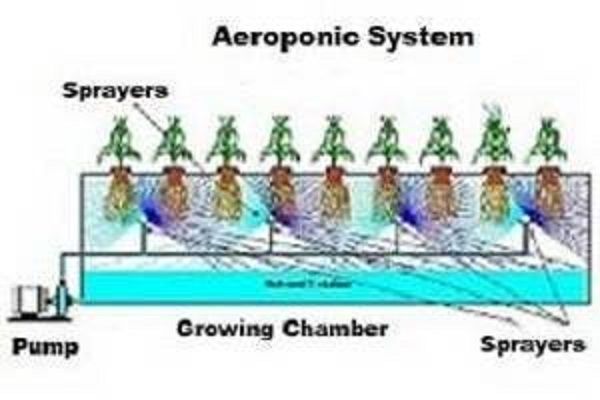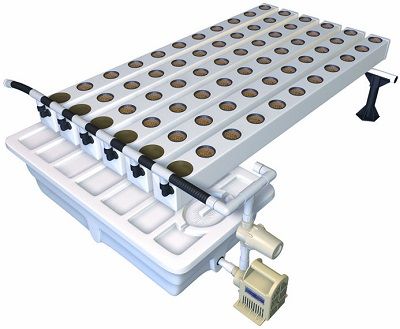Build an Aeroponic System
Using an aeroponic system is a great way to grow plants. This method is accomplished by spraying a nutrient solution to the roots of the plants. There is no use of a medium for this method.
The plants are put into holes on top of a chamber that stands them up with the roots suspended in the reservoir.

The nutrient solution is pumped through the tubing up to a sprayer or mister that spays a fine mist (5-50 micrometers micro-droplets) onto the roots.
An aeroponic system is considered a superior method of growing because of the extra oxygen provided to the root zone.
The end result is faster growth and greater yields.
This method is considered to be advanced because even though it is simple, there is plenty that can go wrong if you are not vigilant.
And there’s the rub. All that really separates advanced methods from the rest is vigilance.
As with any method you use, things can go wrong very fast if you are not paying attention to your plants.
How can an Aeroponic system go wrong?
If you have an aeroponic system that is working properly and you turn your back for 1 hour, it is very possible that you will have an entirely different situation when you return.
What makes aeroponics or hydroponics difficult is “moving/extra parts”. The more parts you have to keep track of, the more difficult it becomes to grow.
Advanced methods tend to have many moving or extra parts such as misters, or sprayers that usually have a tendency to get lost, fall off, get broken or whatever.
Many times these sprayers can fall off or get clogged up inside the chamber so that you are not aware of the mishap until your precious plant is wilted or dried up from the lack of water.
This is more likely to happen when using organic nutrients with sprayers or misters.
So just remember that vigilance is the difference between a great harvest and a poor one.
If you can reach harvest time with out any mishaps, then you will be very satisfied with what you have accomplished.
An aeroponic system can do what hydroponics does but “better”. You will have a bigger and better product in the end.
With that being said, let’s learn how to set-up an aeroponic system properly and avoid common mistakes that beginners usually make.
Method #1 Buy a brand new aeroponic system

Because of the level of difficulty involved with an aeroponic system, I will usually recommend that novices buy a brand new set-up if you are truly interested in using this method.
A professionally built system is easier to set-up and you will need some time to gain experience before you go out and try to build your own.
Method #2 Make your own aeroponic system
I usually only recommend an aeroponic system for advanced gardeners. This method will be difficult for those without at least 1-2yrs worth of experience.
A smaller version of this set-up can be used to clone plants as well. Make sure to use a dark colored chamber to protect the roots from the light.
Supplies
drill
air tubing
air stones
1/2in drill bit
air pump
2in drill bit
water pump
black vinyl tubing
sprayers/misters
reservoir
reservoir cover
digital timer (optional)
Step by Step
Step 1)
Drill 2in holes along the top of the chamber. Place the holes about 2-6in apart. The amount of holes will be determined by the size of the chamber and the amount of plants you wish to grow.
Step 2)
Drill another 1/2in hole on the corner of the top. This small hole will be for the tubing of the air pump*and the plug-in cord from the water pump.
Step 3)
Use the PVC to make a grill shaped square or rectangular configuration. Drill small holes about 1-2in apart along the top of the PVC to insert the sprayers or misters.
Step 4)
Use a PVC T-connector to connect the water pump to the PVC pipes. Make sure to set the T-connector in the center so that it can work as a brace and hold up the configuration.
Step 5)
Fill the reservoir about 1/2 full of nutrient solution. Make sure the water level lies about 1-2in underneath the sprayers.
Step 6)
Plug-in the air and water pumps. Make sure the air pump is making the water bubble and make sure there is a steady flow of water through the sprayers causing a fine mist or spray.
Many would consider the air pump to be unnecessary. Although the air pump doesn’t directly spray water onto the roots, I suggest using it because it can be used as a safety backup to help to keep the humidity up in the chamber to buy you a little extra time in case the sprayers stop working.
Step 7)
–Optional– Some suggest that you use a timer and set the sprayers to 30 sec. or 1 minute intervals. I don’t think this is necessary. Setting the water to continuously spray would be a better option.
Keys to success
The key to making this work will be the location of the sprayers or misters. Make sure they are close enough to spray the nutrient solution directly onto the roots.
If the roots are very small then you may need to hand water the plants until the roots grow enough for the sprayers to reach them.
Some have tried putting the sprayers directly under the plant. This works great if you are using this method to clone and the plants have little or no roots.
But if they are already mature plants with a full root system then this can be problematic if the roots grow onto the sprayers and cover them up.
Another option would be to put the sprayers along the inside wall of the reservoir.
But what I and others have found that works best is to place the tubing along the top of the reservoir and hanging the misters upside down next to each plant hole.
This usually works well without roots growing over the sprayers and getting in the way.
Aeroponic gardening is a great way to grow plants. Just remember that attention to detail is the key to a great harvest.
If you can master the aeroponic system you will be able to harvest superior fruits and vegetables for many years to come.